EDITOR'S NOTE:
They say that God looks after fools, and if that's the case my idiot writer is very well looked after indeed as he accidentally came into contact with Jake Simpson and Eric Kinkead, programmer and artist respectively for this game. The email exchange that followed brought a lot (and I mean a lot) of previously unknown facts about the game to light. We've now peppered this write-up with some of the more interesting quotes from these emails- any quotes from Jake will be pointed out in yellow, and any quotes from Eric will be pointed out in green, both surrounded by quotation marks, just so you can't miss them. Please, enjoy.
You can consider this article as the complete opposite of the Sailor Moon one. Both are about arcade games based on licensed properties, but there's a key difference between the two; I know dick all about Sailor Moon, but I absolutely love Judge Dredd in a way that's probably unhealthy. I usually refrain from talking about myself on the site, but I'm a big Dredd fan, and nothing pleases me more than to leaf through one of the great Dredd epics every now and then. I heartily recommend buying The Complete Case Files collections, they're a great introduction to the series.
Although pretty well known in his home country of Britain, there's every possibility that our American viewers won't know who Judge Dredd is, perhaps only vaguely remembering the 1995 movie, or the song Anthrax wrote about him. I'm really not in a place to assume how well-known he is on the other side of the pond, but while I could bore you with a very intricate explanation of his comic book roots in 2000 AD, or about how over the years the strip has evolved from a blackly humourous bit of escapism into a dark bit of political satire while retaining the gung-ho action of the earlier strips... I won't. Instead, I shall share with you this single image. Remember, this is the epitome, the very essence if you will, of Judge Dredd:
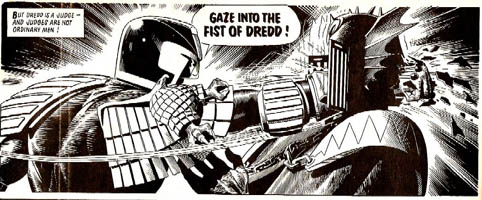
Says it all, really.

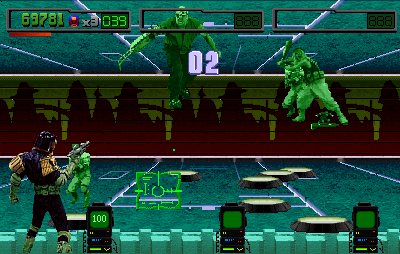
So, after the success of Terminator 2 - The Arcade Game, Midway were looking for another movie license to make an arcade game out of, and since the Judge Dredd movie had been announced at the time, they decided to grab the license and beat the cinemas to it. Utilising a slightly-better form of digitised graphics than the original Mortal Kombat (pioneered in this game) it was planned for release in 1993. Of course, this might seem a bit strange for an American company such as Midway, seeing as Dredd is a British institution, but Jake Simpson- one of the programmers for the game, who was a new employee at the time- explains that 'I'm actually British (through and through), so I knew Judge Dredd really well... All 4 of us on the team were massive fans, so we wanted to do it.'. Eric Kinkead, who was an artist on the game, adds that 'Judge Dredd was very, very underground in the states at the time. In America to be exposed to Judge Dredd you had to be a) from England with a love for English Sci-Fi, b) a comic book nerd ball or c) into heavy metal + art + the crossover of GamesWorkshop and the current English grindcore/thrash movement. I was the 'C' factor to the letter' and that 'I remember John Vogel and Tim Colman taking particular interest in a rendering in my sketchbook of Judge Anderson of the PSI division'. You can tell that this was made by fans, because there's some really neat references to the original comics that made me titter like an excited schoolgirl when I caught them, like the hopeless nerd that I am.
However, there's something very odd about the arcade Judge Dredd- it was never released. Hell, it wasn't even completed, but was playtested in Chicago- 'we were still relatively early in development to be testing - normally the game doesn't go out on test till it's 100% complete and we weren't - but we were starting to get glimmers of the fact that this wasn't going to be great and we wanted to know early so we could just put a bullet in it and stop wasting our time, if that was the case.'. Unfortunately, the locaction test didn't quite go to plan (we'll go into the specifics a little later), so the plug was pulled on the project. Fortunately, the game was preserved, to an extent- although only four boards were ever made, a version of the game slightly older than the version play-tested was dumped and is available to play in MAME. Only through the miracle of emulation can we play Dredd's first arcade game... Sure, Gremlin released their own Dredd arcade game a few years down the line, but this is the Dredd game we never saw!
The general plot of the comics- and, as such, the game- is cheerfully outlined in the attract mode:
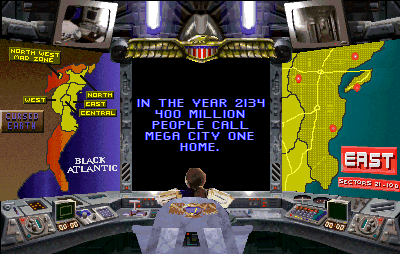
As Dredd, you hit the streets and bring your own brand of justice. Remember, he is the law- and you'd better believe it!
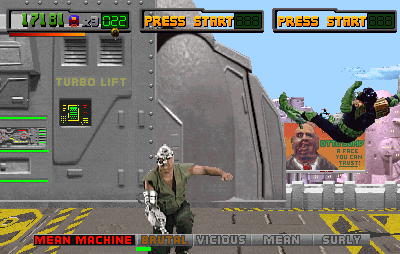
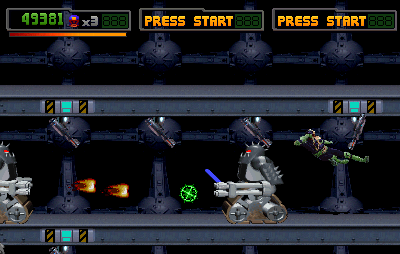
The nature of the original comic books make them ideal fodder for a lightgun game, seeing as Dredd loved to use his Lawgiver to dispense justice with wanton abandon- this is the form the Gremlin game took- but ultimately, inspiration came from a different source- 'the actual premise of the game was it was supposed to be a cross between MK and Teenage Mutant Ninja Turtles - we literally had one in my office to play, the 4 player version... '. So yeah, it's a scrolling brawler! You should be familiar with what's gonna go down by this point- just fight through waves of enemies, and beat the boss character at the end of the stage. In fairness, it's a rather sophisticated one for its time, as each stage is different in some way, be it the controls or the mission objective. It's definitely a different approach than the norm- 'We wanted each level to have a different mechanic (although not too different) because at the time, no one else had done that, at least not in a brawler.'- although it has to be said that not all of it works... The controls are odd too, as the game has not 2, not 3, but 4 buttons, very unusual for a scrolling brawler at the time. The Jump and Crouch buttons are universal to each stage, but the other two change depending on the mission- sometimes they're for punching and kicking, other times for firing Dredd's Lawgiver.
The controls are a little awkward, truth be told. This is mostly because, unlike games like Final Fight and Sailor Moon, Dredd can attack enemies in the eight cardinal directions- left, right, towards the screen, and away from the screen, and the four directions in-between. This is a nice idea, in theory, but it not only means that the enemies have 2 extra directions from which to attack you, it also means that trying to judge (arf! arf!) whether you're going to hit the enemy when attacking towards/away from the screen is a bit difficult. You can avoid this problem most of the time, though, as the screen's relatively uncrowded (and quite small) and it stops being a problem on Stage 2 when you've got your gun. Another problem is the Crouch button, which you'll need to pick up items, unlike every other beat-em-up ever made. You can also use the Crouch button to perform a Mortal Kombat-esque uppercut (press Punch) or drop a grenade, killing any enemies nearby (press Kick or Jump). The only other 'special' move is a jump kick, which you can perform by pressing either Kick or Jump while in the air. You'll get used to it eventually, but what baffles me the most is the apparent layout of the buttons on the cabinet...
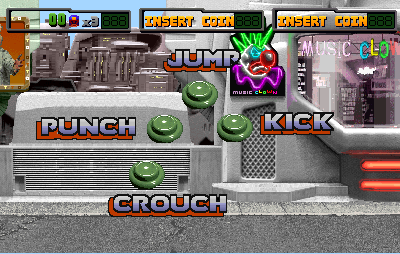
I hope you caught all that, it won't be repeated.
Now, I know what you're thinking. "God-damn, that's one hideous layout!". In fact, I thought the same thing when I first slapped eyes on the control scheme- I mean, look at it. Look at where the Crouch button is- it seems like it's miles away from the other buttons (which wouldn't be so bad if the Crouch wasn't necessary for so much stuff in this game). However, it turns out this isn't the first time such a wretched control scheme was used in the arcades- the layout is actually recycled from NARC, Williams' ultra-violent (and ultra-shite, let's be honest) run-and-gunner. The control panel was used because 'everyone else said it had worked out well with Narc. This was my first game, so I just let it go.'. Fortunately, since MAME is literally the only way to play this game, you can reconfigure the controls to your liking (on a SNES controller via USB, the Crouch button is best assigned to the shoulder buttons) and you won't have to put up with this awkward scheme.
With the controls out of the way, let's deal with the items.
Again, this changes depending on the stage- Stage 3 has several unique items, so we'll deal with them then. The generic ones are...:

Judge's Badge
This item gives you temporary invincibility. It's an overpowered item, as the invincibility almost lasts forever...
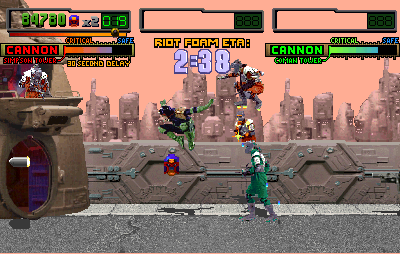
Judge's Helmet
This gives ol' Stoney Face a boost to his health. You'd assume it was an Extra Life item, but noooo...
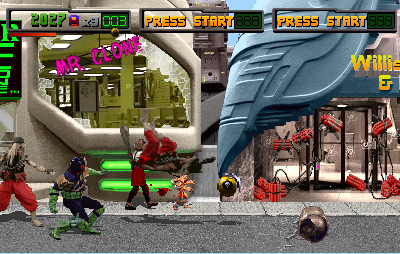
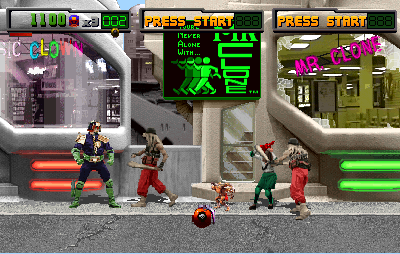
Grenade
There's two types of Grenades available- Yellow and Red.
Picking up a Yellow Grenade gives you another grenade (although the grenade counter only ever shows one grenade, you can carry more).
Grabbing a Red Grenade kills everything on screen instantly.
There's very little else to say, to be honest, as the game's short because it's unfinished- 3 main stages, and a bonus stage after each mission. Fortunately, I'm not going to let you people down, as there's a lot of extra stuff to deal with after the main game's over... And in the game itself too. So, let's hit the streets of Mega-City One- let's play Judge Dredd!
The game starts on the next page, so you'd better read on, drokk it!











